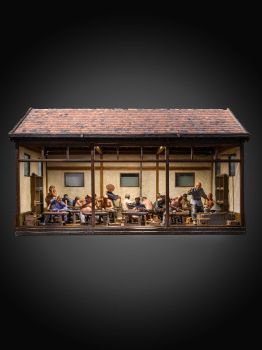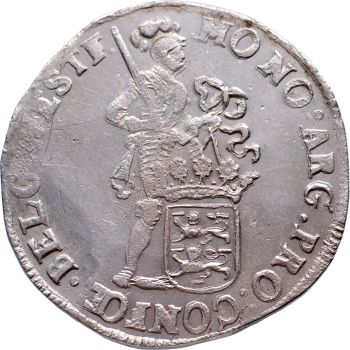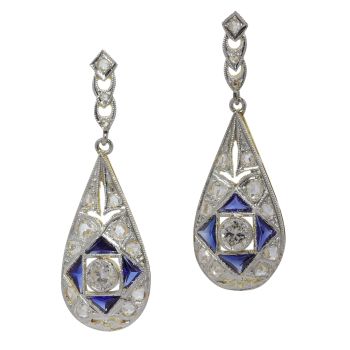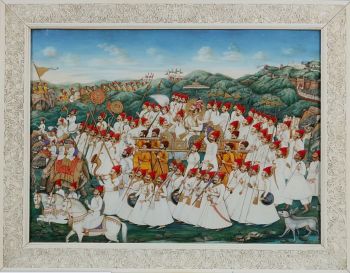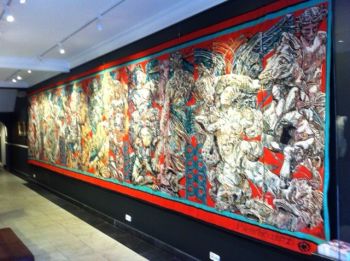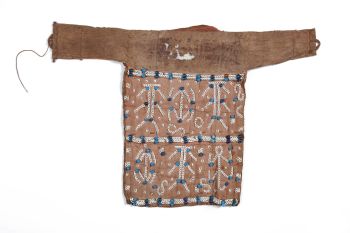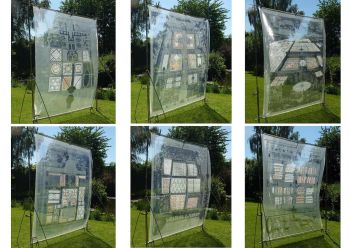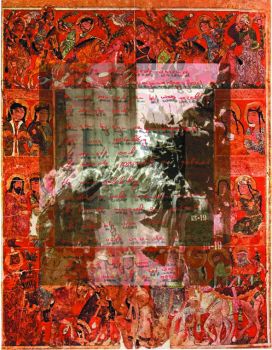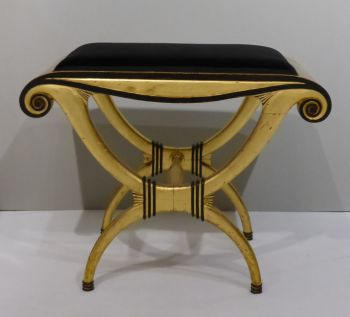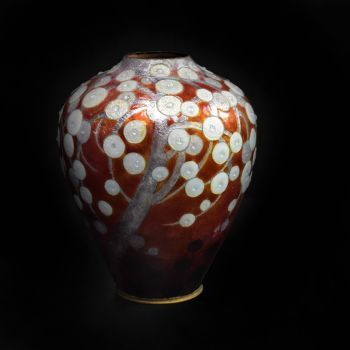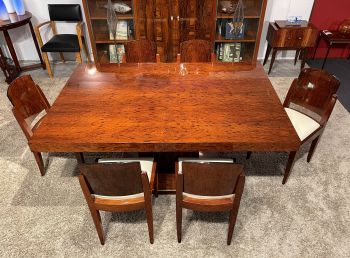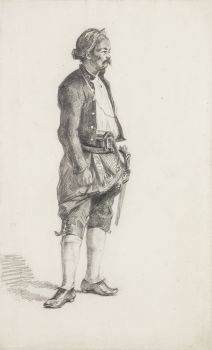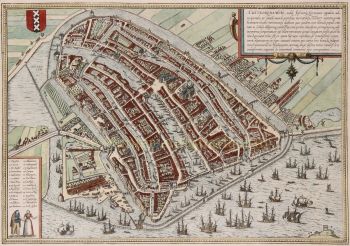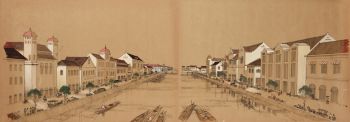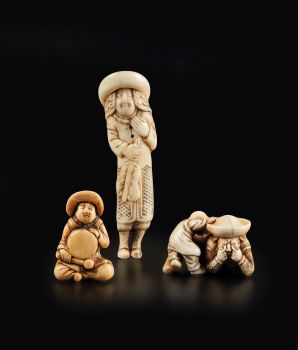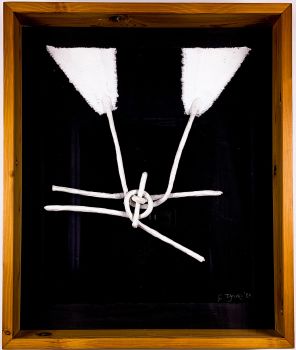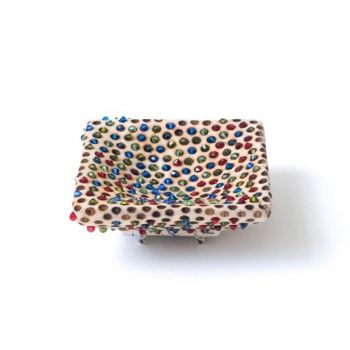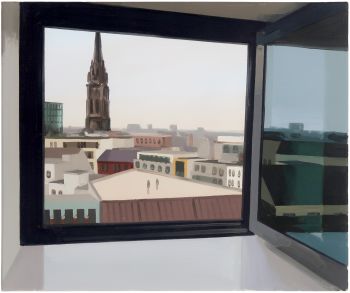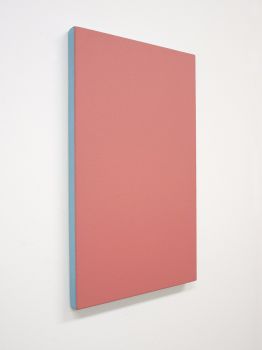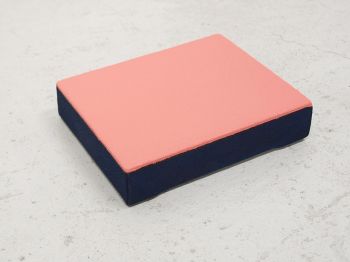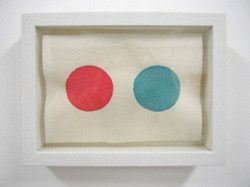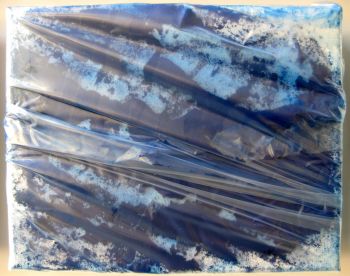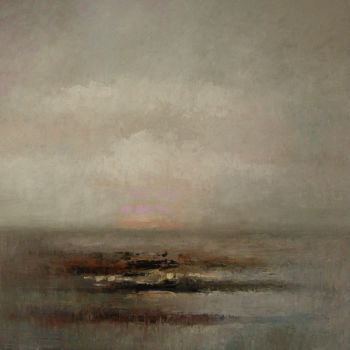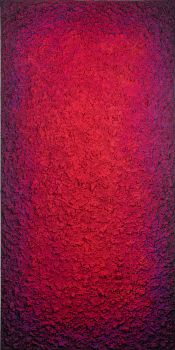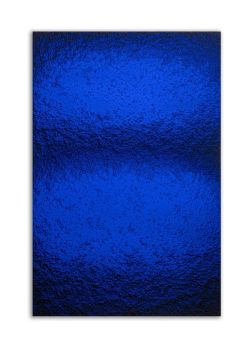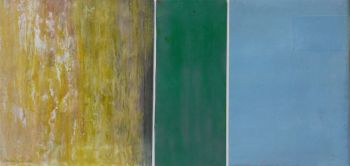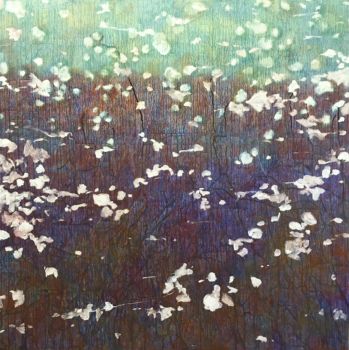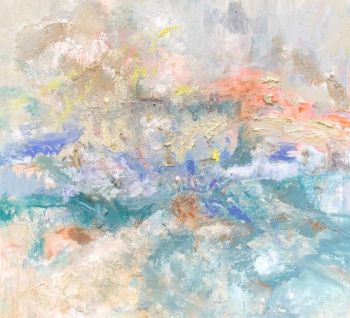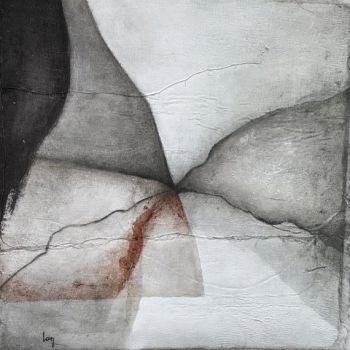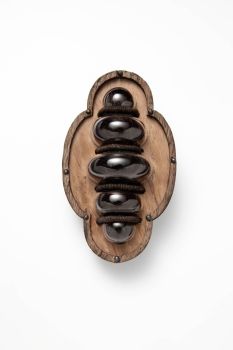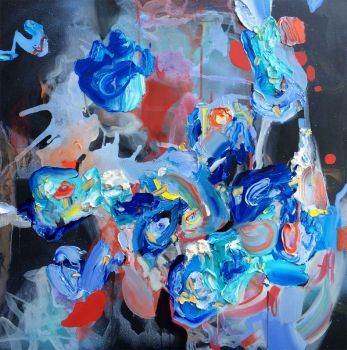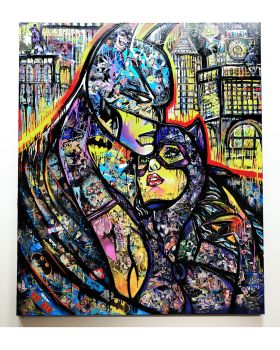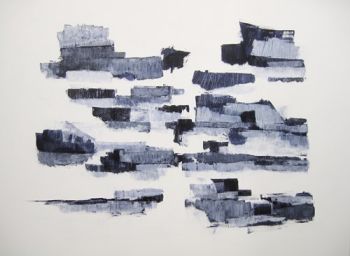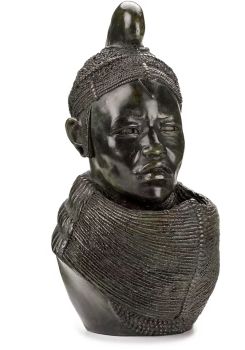A very rare Indian Armorial Palempore Chintz for the Dutch Market 1750
Artista Sconosciuto
Tessilecotone
333 ⨯ 225 cm
Prezzo su richiesta
Zebregs & Röell - Fine Art - Antiques
- A proposito di opere d'arteCoromandel coast, probably Sadraspatnam (Sadras), first half 18th century
Cotton, mordant- and resist-dyed, painted, 333 x 225 cm
“Palempore” refers to large chintzes laid on a bed or hung behind it. The present very large palempore in the centre shows a coat of arms with a redish salient deer in front of a green tree on the ground, the crest with a deer issuant. The mantling shows scrolling leaves and European style scrollwork in red and green, within a circle of flowers. In the corners of the white field four vases with large flower bouquets. The borders are decorated with undulating vines with flowers and leaves issuing from large flowers and leaves in each corner and in the middle of the long sides.
The coat of arms probably belongs to Jacob Hartogh (Leiden, 30 October 1701 - Delft after 1756), a cloth manufacturer in Leiden. His father, Hendrik Hartogh, a cloth-shearer, emigrated from Bremen to Leiden at the end of the 17th century. He married Jannetje Pieters in 1701 and the couple had two sons, Jacob and Jan. Jacob, from 1740 till 1756, owned a cloth factory at the Turfmarkt in Leiden. In 1756 he sold the factory and settled in Delft. Jacob married twice, first to Katharina Paré (1697-?) in 1721, and secondly some time before 1735 to Marianne Petit (1708-?). His son from the first marriage, Michiel Hartogh, also became a cloth manufacturer in Leiden and his descendants held public posts in Delft and Rotterdam during the second half of the 18th century.
Jacob possibly ordered the palempore somewhere shortly before 1735. Jacob presumably also ordered an armorial chine de commande tea set, dated between 1730 and 1735, of which only some cups and saucers survive. The coat of arms on the tea set consists of a tree on the ground with a yellow tripping deer in front, the crest with a yellow deer issuant, and the mantling with polychrome scrolling leaves (Dr. Jochem Kroes, Chinese Armorial Porcelain for the Dutch Market, Waanders Publishers, Zwolle 2007, pg. 168).
Several other similar armorial chintzes all bear the arms of Frisian and Groninger families; Goslinga (Rijksmuseum, inv. BK-1980-795), Burmania (Rijksmuseum, inv. BK-1980-98), Alberda-Horenken-van Berum, Rengers van Welderen, and Douma van Langweer (Ebeltje Hartkamp-Jonxis, Sitsen uit India Indian Chintzes, Rijksmuseum Amsterdam 1994). Ebeltje Hartkamp-Jonxis dates these armorial chintzes to a short period between 1725 and 1730. The present palempore appears to be the only one of this design, probably ordered by a family from the province of Holland. Armorial palempores with different designs are known from Holland and Zeeland. - A proposito di opere artista
Può succedere che un artista o un creatore sia sconosciuto.
Alcune opere non sono determinate da chi sono state realizzate o sono state realizzate da (un gruppo di) artigiani. Esempi sono statue dell'antichità, mobili, specchi o firme non chiare o leggibili ma anche alcune opere non sono affatto firmate.
Inoltre puoi trovare la seguente descrizione:
•"Attribuito a …." A loro avviso probabilmente opera dell'artista, almeno in parte
•“Studio di ….” o “Officina di” A loro avviso un'opera eseguita nello studio o nella bottega dell'artista, eventualmente sotto la sua supervisione
•“Cerchio di…” A loro avviso un'opera del periodo dell'artista che mostra la sua influenza, strettamente legata all'artista ma non necessariamente al suo allievo
•"Stile di..." o "Seguace di..." A loro avviso un'opera eseguita nello stile dell'artista ma non necessariamente da un allievo; può essere contemporaneo o quasi contemporaneo
•“Modalità di…” A loro avviso un'opera nello stile dell'artista ma di epoca successiva
•"Dopo …." A loro avviso una copia (di qualsiasi data) di un'opera dell'artista
•“Firmato…”, “Datato…” o “Iscritto” A loro avviso l'opera è stata firmata/datata/inscritta dall'artista. L'aggiunta di un punto interrogativo indica un elemento di dubbio
•"Con firma....", "Con data...", "Con iscrizione..." o “Riporta firma/data/iscrizione” a loro avviso la firma/data/iscrizione è stata aggiunta da qualcuno diverso dall'artista
Sei interessato ad acquistare questa opera d'arte?
Artwork details
Related artworks
Artista Sconosciuto
19th C SCALED MODEL OF A CHINESE WORKSHOP WITH 17 POLYCHROMES TERRACOTTA FIGURES1880 - 1900
Prezzo su richiestaSpectandum Gallery
1 - 4 / 12Joseph Savart
Four portraits of women of Guadeloupe1769
Prezzo su richiestaZebregs & Röell - Fine Art - Antiques
Paulus Franciscus Kromjong
Fiori davanti ad Arearea Aka (gioia) di Gauguin'20th century
Prezzo su richiestaZebregs & Röell - Fine Art - Antiques
Artista Sconosciuto
UN INSOLITO PIATTO D'ARGENTO LOBBATO INDONESIlate 17th
Prezzo su richiestaZebregs & Röell - Fine Art - Antiques
Artista Sconosciuto
A Dutch colonial Indonesian betel box with gold mounts1750 - 1800
Prezzo su richiestaZebregs & Röell - Fine Art - Antiques
Artista Sconosciuto
A silver spoon commemorating Juff’ Margareta van Hoorn1656 - 1694
Prezzo su richiestaZebregs & Röell - Fine Art - Antiques
Artista Sconosciuto
A Surinam-themed Amsterdam long-case clock1746 - 1756
Prezzo su richiestaZebregs & Röell - Fine Art - Antiques
 A cura di
A cura diGallerease Magazine
Artista Sconosciuto
A superb Indonesian royal gem-set gold overlaid silver betel box19th century
Prezzo su richiestaZebregs & Röell - Fine Art - Antiques
Artista Sconosciuto
IMPORTANTE E RARO GRANDE DIPINTO INDIANO "COMPANY STYLE" SU AVORIO RAFFIGURANTE UNA SFILATA1850 - 1900
Prezzo su richiestaZebregs & Röell - Fine Art - Antiques
 A cura di
A cura diDanny Bree
Artista Sconosciuto
Japanese transition-style lacquer coffer 1640 - 1650
Prezzo su richiestaZebregs & Röell - Fine Art - Antiques
1 - 4 / 24Artista Sconosciuto
UN NETSUKE MARINO IN AVORIO DI UN OLANDESE CHE TIENE UN FAN . CINESE18th century
Prezzo su richiestaZebregs & Röell - Fine Art - Antiques
Artista Sconosciuto
UN RARO SADELI INDIANO COMPLETO DI LAVORO E SCRITTURA INTARSIATI1800 - 1850
Prezzo su richiestaZebregs & Röell - Fine Art - Antiques
Artista Sconosciuto
The Stamford Raffles Secretaires.1800 - 1813
Prezzo su richiestaZebregs & Röell - Fine Art - Antiques
1 - 4 / 24Artista Sconosciuto
Due ritratti di studio di Mas Marco Kartodikromo1900 - 1950
Prezzo su richiestaZebregs & Röell - Fine Art - Antiques
Artista Sconosciuto
UN CONTENITORE PER DOCUMENTI DELLO SRI LANKA IN ARGENTO DORATO19th century
Prezzo su richiestaZebregs & Röell - Fine Art - Antiques
Artista Sconosciuto
UN RARO SADELI INDIANO COMPLETO DI LAVORO E SCRITTURA INTARSIATI1800 - 1850
Prezzo su richiestaZebregs & Röell - Fine Art - Antiques
 A cura di
A cura diDanny Bree
Artista Sconosciuto
Olandesi in miniatura18th century
Prezzo su richiestaZebregs & Röell - Fine Art - Antiques
Artista Sconosciuto
COPPIA DI TORCHÈRE O PORTACANDELE IN TEAK INDONESI LACCATI E DORATI18th century
Prezzo su richiestaZebregs & Röell - Fine Art - Antiques
Artista Sconosciuto
UN INSOLITO PIATTO D'ARGENTO LOBBATO INDONESIlate 17th
Prezzo su richiestaZebregs & Röell - Fine Art - Antiques
Artista Sconosciuto
A large Japanese Imari porcelain 'VOC Groningen' dish1800 - 1925
Prezzo su richiestaZebregs & Röell - Fine Art - Antiques
Artista Sconosciuto
UN MODELLO GIAPPONESE DI UN NORIMONO, UN PALANQUIN1650 - 1700
Prezzo su richiestaZebregs & Röell - Fine Art - Antiques
Artista Sconosciuto
UN NETSUKE IN AVORIO DI UN OLANDESE CHE GIOCA CON UN RAGAZZINO18th century
Prezzo su richiestaZebregs & Röell - Fine Art - Antiques
1 - 4 / 24Shinkichi Tajiri
“Koan” 1988 – papier-mâché / cotton on paper, original frame1988
Prezzo su richiestaVan Kerkhoff Art
1 - 4 / 24Artista Sconosciuto
UN RARO GRANDE TELESCOPIO GIAPPONESE IN PELLE LACCATA1750 - 1800
Prezzo su richiestaZebregs & Röell - Fine Art - Antiques
Philip Reeves
A Massai/Rendille tribe girl from Kenya1952
Prezzo su richiestaZebregs & Röell - Fine Art - Antiques
Artista Sconosciuto
A Dutch colonial Indonesian betel box with gold mounts1750 - 1800
Prezzo su richiestaZebregs & Röell - Fine Art - Antiques
1 - 4 / 12



